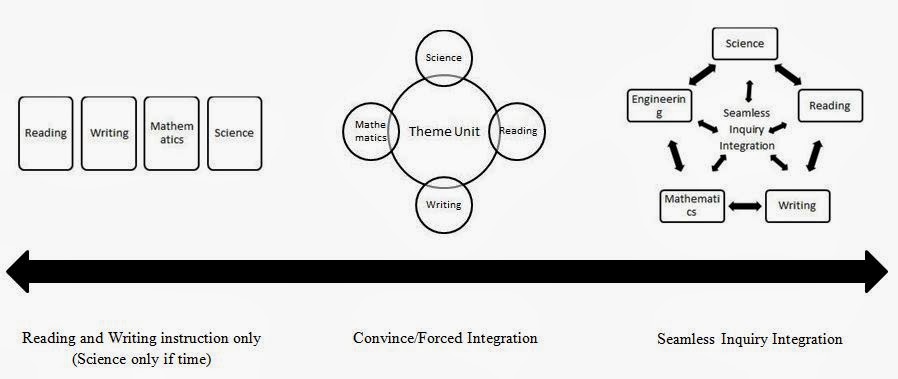A word that I often use to describe our instructional practices at Benton is "integration". For most teachers and educators, this is not a new term. I spent hours reading and researching about integration in education while working on my dissertation. However, the problem with this term is there are a wide range of definitions and interpretations for this term.
I can remember in elementary school we would have units of study on dinosaurs or penguins. While I realize I have no idea the planning that went into these units, it doesn't seem the selection of learning experiences were very purposeful and connected. Sure, we wrote about dinosaurs, made a stuffed paper dinosaur, and read books about dinosaurs. However, it seems the focus was more on the topic, dinosaurs, than the learning objectives in reading, writing, science, social studies, and mathematics.
The unit of study described above seems to be more of a forced type of integration. In my dissertation, I developed a continuum to help provide a visual for my understanding of integration (see below).
In this continuum, the left side indicates instruction that is separate (not in time of day taught, but making connections across areas) and may or may not include science and/or social studies instruction. The middle stage would be where the dinosaur unit would fit in that I described above. On the right would be (in my mind) what seamless, purposeful integration looks like in a classroom.
Seamless integration is the direction I think all teachers at Benton are headed with their planning, reflection, and instruction. What exactly does this mean? I want to start by clearing up a misconception that often occurs when a teacher begins to think about integration in the classroom. I know this because this was the misconception I had when I first began exploring integration and what seamless integration can look like in any classroom. This misconception has to do with what content is taught when during the day. Just this weekend, I was asked if our teachers have a math time, reading time, science time, etc. When I responded yes, the next comment was "so you are not integrating among content areas right?" My answer to this question gets a little more complex. You can integrate among content areas while still having separate times for the different areas.
I know many of you are still thinking...so what exactly does that look like in a classroom? For many of our teachers, it comes down to their planning, reflection, and instruction practices. The teachers who have become more comfortable with seamless integration often decide to start with their science standards and concepts. Then, they look at what nonfiction/fiction texts can they use during reading and writing time as mentor or guided reading texts that connect to the science concepts. Next, they think about their writing time and Common Core State Standards to find ways to have the students write about their science learning through applying the writing skills and practices they are working on. Finally, they look at the CCSS in math and how those skills connect to their science concepts. By purposefully looking for connections across all content areas, they are making it easier to point out these connections to students during the lessons.
I think one of the biggest differences between the dinosaur unit I remember from early "integration" and the seamless integration happening at my schools is where the planning and lesson development starts. Our teachers start with the standards and purposefully look for how those standards are connected. At this point, our teachers are in the process of developing integrated units of study that demonstrates the connections across content areas. They use the Understanding by Design framework to guide their planning. More information on this framework can be found at http://www.ascd.org/research-a-topic/understanding-by-design-resources.aspx. I hope to share more of these plans as teachers finishing developing them this year. The most important thing to keep in mind is the development of these units is a process and they will become more detailed and complex as teachers spend more time planning, teaching, and reflecting on them.

No comments:
Post a Comment